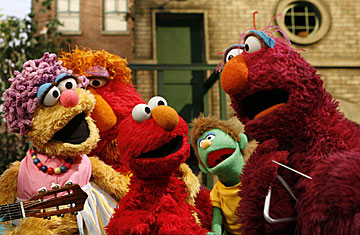
Street Gang: The Complete History of Sesame Street
By Michael Davis
Viking; 379 pages
The Gist:
The biggest juggernaut in children's-television history sprang forth from mundane origins. At a Manhattan dinner party in 1966, a Carnegie Foundation executive named Lloyd Morrissett mentioned that his young daughter was so enthralled by television that she would park herself in front of the family's set to gaze at early-morning test patterns. That story prompted a public-television producer named Joan Cooney to investigate how television could be used to package education as entertainment: "What if it went down more like ice cream than spinach?" The ensuing creation — in which kids learned everything from empathy to arithmetic under the tutelage of colorful creatures like an 8-ft.-tall canary and a misanthropic garbage-can dweller — was greeted with acclaim by parents, teachers and even President Richard Nixon. Four decades later, it's a cultural touchstone that remains required viewing for millions of youngsters in 120 countries.
Highlight Reel:
1. On how the upheaval and idealism of the 1960s inspired the show's socially conscious team of creators:
"They came together at a star-crossed moment in American life when people of means who lived in comfort chose to dedicate their energies to the less fortunate and the forgotten, the rural poor and the underprivileged of the urban ghettos. Sesame succeeded beyond their wildest imaginings and, in doing so, changed the world, one child at a time."
2. On the partnership between the show's key pilots, Jim Henson and Joan Ganz Cooney: "It was Henson who helped the grandest and most ambitious experiment in children's television find its legs ... Henson's touch helped definitively establish Sesame Street's 'delicate balance between fun and learning,' as he once described it. Cooney understood from the show's earliest days, back before it became a brand of excellence here and around the globe, that using television to teach the alphabet and counting to twenty would have been a noble effort, but not nearly as much fun, without him."
3. On the appeal of the Muppets that formed the show's backbone and became a cultural franchise of their own: "Considering that most Muppets start out as bath mats with appliqués, it's fairly miraculous that they seem to have more dimensionality to their personalities than do most human characters on television ... [Henson] understood that viewers would suspend their sense of disbelief if they saw pieces of themselves in the characters. Forgetful Jones had a foible, and he was therefore funny and as recognizable as the elderly neighbor who always seemed surprised when the paper boy came to collect on Fridays. The Count had an obsessive need, and who doesn't? Telly fretted, Oscar kvetched, Ernie teased, Bert was anal, and Grover, like most of us, was, if not always a superhero, certainly above average."
The Lowdown:
Davis, a veteran journalist at publications like TV Guide, culls insights from the show's creators and cast to serve up this painstakingly detailed history of television's most famous address. He writes as an unabashed fan of the show's charms rather than as a dispassionate historian, and the approach yields mixed results. His interviews are revealing, but the portraits of Sesame Street's creators can be hagiographic and the language breathless: at one point, he describes the observation that television could be harnessed for educational purposes as a "flash of brilliance that struck like a bolt from the gods." Still, some things are worth gushing over. And this meticulous story of a program that TIME anointed in 1970 as "not only the best children's show in TV history [but also] one of the best parents' shows [ever]" is well deserved.
The Verdict: Skim
